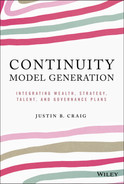Keystone Meta-Framework
Knowledge of this meta-framework's keystone, four theoretical approaches, two logics, and three circles will enable anyone to understand and interpret with some authority the complexity of the tripartite family, business, and ownership landscape as well as gain insight into how these areas function independently and interdependently.
Four Foundational Theoretical Approaches
Agency Theory
Agency theory explains so much of the world. Originating in arguments presented as early as 1932, agency theory describes what happens when owners appoint others to act on their behalf—or, in the theoretical jargon, when principals appoint agents. The core argument is that any organization, at some point, will reach a stage, due to growth or expansion, where the principal cannot do everything that needs to be done, so they must appoint someone to do some of the work. This eventuality brings about or facilitates a cost: the person, or agent, appointed by the principal to act on their behalf will require monitoring, which incurs agency costs, also known as monitoring costs. As a leader of a third-generation European family enterprise shared insightfully, “My sole job is to reduce agency costs.”
Broadly, then, the job of a leader is to put in place mechanisms in the organization to ensure that agents’ behavior is aligned with interests of the principals. This alignment is achieved through incentives and perquisites.
Importantly, agency costs occur throughout an organization. At the organization's head, agency costs appear when the owners appoint the board to act on their behalf. The board is monitored through measures such as the strategic planning process and other governance-related and regulatory mechanisms to ensure those appointed by the owners truly act on their behalf. This is predominant in publicly traded companies but is also the case for private companies, particularly in mature generational businesses with more complex governance structures.
Moreover, one of the responsibilities of the board of directors is to appoint and monitor the CEO. Agency costs, or the potential for agency costs, will occur if the CEO's actions, decisions, or behaviors are not aligned with those of the board of directors, who are acting as representatives of the owners.
Moving down through the organization, there are also potential agency costs when the CEO appoints their management team. This potential eventuates if those top executives are not aligned amongst themselves.
If you keep the thread going, further down the organization the senior management team is charged with overseeing different areas, be it marketing, finance, IT, logistics, sales, or others. Again, there is potential for agency costs in misalignment of the senior management team with those appointed as division leaders or department heads.
These middle managers or supervisors, in turn, will employ line staff, resulting in yet another principal–agent dyad, and the potential for more agency costs.
As such, an organization represents a chain of principals and agents, with the same individuals or entities taking on either role, depending on the dyad relationship in question. Recall, at the top of the organization, the principal was the owner, and the board was the agent; then the board was the principal, and the CEO was their agent; then the CEO was the principal, and their agent was the top management team. The top management team members then represent the principal in their dyadic relationship with their line employees. And so on.
So, as should be evident, agency costs, or the potential for agency costs, are ubiquitous throughout all organizations. It is for this reason that agency is one of the frameworks in the keystone meta-framework.
Family enterprises are not immune to agency costs, or the potential for agency costs. They too incur costs throughout the organization and the family. In the early days, the owners are also the managers, so there is a reduction of agency-related costs. But as the company evolves and the family grows, the owners typically must appoint non-family employees and managers to assist in operations and non-family directors to assist in governance. Family and non-family members will contribute to the potential for agency costs if they are not aligned with the values, beliefs, or vision of the core ownership group.
In family enterprises there are four specific categories of agency costs. The first category is probably the most common and easiest to comprehend: entrenchment. Here, a founder, or any senior executive or other employee becomes entrenched in their position and their way of doing things. This happens not only in the domain of business-owning families, but, typically, entrenchment-related agency costs will be incurred if a senior executive or, particularly, an incumbent leader is not willing to succeed responsibility to the next generation and stays too long in their role. These costs relate to being wedded to old ways and the unwillingness to embrace change and innovation, which, paradoxically, were likely the hallmarks of the executive's earlier leadership and a major reason for their success.
The second theoretical dimension related to agency costs is adverse selection. This effectively says that the best person for a given job or position should be appointed regardless of whether that individual is family or non-family. As is the case for non-family businesses as well, there is a large potential to incur agency costs should the wrong person be appointed, such as when nepotism is involved.
The third agency-cost-related category relates to information asymmetry. Here, there will be cost incurred, or the potential for costs, if information is kept from people who should be given access to it or used inappropriately by those with access. For example, information asymmetry manifests in the form of insider trading in publicly traded companies, when someone who has access to superior information acts on that information to benefit themselves at the company's expense. This type of cost is potentially rife in family enterprises where those working for the business in day-to-day operations or in executive roles have access to information that those not working in the business lack. It also manifests in boards, when a board member has access to information others do not and acts on that information in an inappropriate way.
Finally, the potential for agency costs is also associated with altruism. Here the problem can be that all family members will be treated equally—such as offered the same compensation or similar-level business roles—despite their divergent contributions to the business or the family in governance or other roles. This is a recipe for disaster.
To recap, entrenchment is when incumbents overstay their welcome, preventing effective succession; adverse selection is also known as nepotism and causes problems when family members are appointed to positions for which they are not qualified; information asymmetry, also known as insider trading in publicly traded companies, denotes situations where access to superior information is used inappropriately; and altruism, in this context, involves treating everyone equally regardless of what they contribute (Illustration 2).

Illustration 2 AGENCY
Achievement of continuity requires understanding and minimizing agency-related costs. One way to do that is through the Continuity Canvas's four essential plans. A fundamental continuity model concept, and a key way to reduce agency costs, is to ensure that agents act as stewards, as we discuss next.
Stewardship Theory
Stewardship theory defines relationships based on behavioral premises not addressed by the principal–agent interest divergence that agency theory poses. According to stewardship theory, agents’ objectives can be aligned with those of the organization, and the utility gained through pro-organizational behaviors is higher than those gained through individualistic, self-serving behaviors.
If the agent is intrinsically motivated, they will most likely design an organizational setting where higher-order needs are encouraged and fostered. In an effort to pursue these higher-order needs, agents will be motivated to work harder on behalf of the organization, a condition that aligns their behaviors with their principals’ interests. Under such conditions, the potential for opportunism is reduced (but not eliminated) as agents gain little or no utility (and, in fact, may lose utility) by pursuing tangible, self-serving economic rewards. The more agents value intrinsic rewards, the less likely they will be to deviate from the interests of the organization and the more likely that they will protect their principals’ interests.
According to stewardship theory, the stewards’ objectives are aligned with those of the organization and its stakeholders, including goals such as sales growth, innovation, and profitability as well as nonfinancial objectives, such as ensuring the passing of the firm to the next generation. Indeed, stewards not only recognize their obligation to protect the interests of the organization but also believe that they are morally obligated to pursue them.
According to Jim Davis, David Schoorman, and Lex Donaldson, the authors of the seminal stewardship work (Davis, Schoorman, and Donaldson 1997), stewardship can be characterized by six interrelated dimensions: intrinsic motivation, organizational identification, use of personal forms of power, collectivism, low power distance, and involvement orientation (Illustration 3). They propose that, unlike agency theory, which emphasizes economic rationality, the concept of stewardship captures other-focused, prosocial non-economic behaviors. More specifically, in contrast to agency-based situations, where extrinsic, tangible, and exchangeable commodities are used to motivate and reward employees, a stewardship-based environment will emphasize intrinsic rewards that foster intrinsic motivation, such as opportunities for personal growth and achievement, affiliation, and self-actualization. To fulfill these higher-order needs, stewards’ intrinsic motivation will push them to work harder on behalf of the organization, which in turn aligns their behaviors with their principals’ interests. Generally, stewards will work harder to achieve the organization's goals when they believe their work is meaningful and their tasks are significant.
Organizational practices that emphasize employee growth and signal managerial support to employees can provide stewards with the rewards they seek and nurture their intrinsic motivation.
Another key distinction of stewardship is that it fosters members who identify with the organization and view it as an extension of themselves. According to Davis et al. (1997, p. 29), “identification occurs when managers define themselves in terms of their membership in a particular organization by accepting the organization's mission, vision, and objectives.” Stewards, therefore, have a strong sense of attachment to their organizations, possess high levels of psychological ownership, and wish to see their organizations succeed. Relatedly, stewards have a psychological preference for using personal power instead of institution-based forms of power. Rather than flowing from formally established authority, personal power stems from interpersonal relationships, is often built over time, and is based on mutual trust, norms of reciprocity, and information exchange.
From an organizational—as opposed to individual—level, stewardship directs behavior toward enhancing the collective good. A collectivist organization emphasizes the accomplishment of organizational goals, and individuals define themselves as part of the organization, one in which group identity and a sense of belonging reign supreme. That is, organizations with a stewardship climate are more likely to emphasize collectivism over individualism.
Such organizations are also identifiable by low power distances between managers and subordinates. Power distance is the extent to which less powerful members of an organization accept an unequal distribution of power across organizational levels. In organizational settings characterized by a high power distance, people with less power are dependent on those with high power and status, and special privileges are given to those with higher rank. Conversely, in organizations with low power distances, processes and interactions are egalitarian, inequalities are discouraged, and members are treated equally.
Finally, stewardship engenders a high involvement orientation. High-involvement work practices expand employee autonomy and involvement in decision-making processes and produce beneficial results for organizations and their employees. For example, such systems offer employees the chance to expand their knowledge and task-level expertise, involve people across levels in important organizational processes, and link individual performance to organizational outcomes. Reward systems are linked to performance in a way that instills individuals with the desire to accomplish organizational goals. Such involvement-oriented management environments, in which people are enabled to reach their potential and awarded increasing responsibilities and challenges, are consistent with a stewardship orientation and with the pursuit of aligning individual and organizational objectives.
We can plot the six dimensions of stewardship on a series of continua. For example, motivation can be anchored by extrinsic at one end and intrinsic at the other. For culture, it is collectivist and individual; power distance is high versus low; involvement orientation is involved versus detached; power is positional versus personal; the extent to which individuals view the business as an extension of themselves is high versus low. It is important to note that each of these dimensions, depicted through the series of continua, do not represent an either–or, or all–or–none, situation. For example, someone is not either intrinsically or extrinsically motivated; they will fall somewhere along that dimension. Thus, we can better understand stewardship by recognizing that a recommended position along a given continuum leans toward the preferred stewardship characteristic end.
Integrating the stewardship and agency arguments, or theoretical perspectives, we can suggest that it is preferred that agents appointed by principals are stewards. Below we embellish this further with the addition of the steward, or the concept of stewardship, to the three circles framework.
Without giving too much away, but as a way to reinforce the conceptualization of agents as stewards, continuity modelling is predicated on the notion that owners need to be stewards, that families need to be stewards, and that managers need to be stewards, who are more likely to: be intrinsically motivated, see the business as an extension of themselves, and use personal rather than positional power in companies characterized by collectivist cultures, low power distances, and a strong involvement orientation.
If being a steward is at one end of a continuum, what is at the other? It was only recently that I have begun to figure this out. The inverse to being a steward is being a corporate psychopath. This may sound confronting, and it is. The characteristics of a corporate psychopath, as defined in the psychology literature, can easily be accessed, and this is encouraged if you, like me, were wanting to better understand others who thrived in plain sight, even though their behaviors were so contrary to others in the system. A cursory review of this literature will reveal that while the word “psychopath” is a popular one, it's a colloquial term, not a medical one. The technical diagnosis that appears in the Diagnostic and Statistical Manual of Mental Disorders is “antisocial personality disorder.” A closer investigation will reveal that psychopathy is one of three traits that make up what the personality psychologists refer to as the Dark Triad, with narcissism and Machiavellianism being the others.
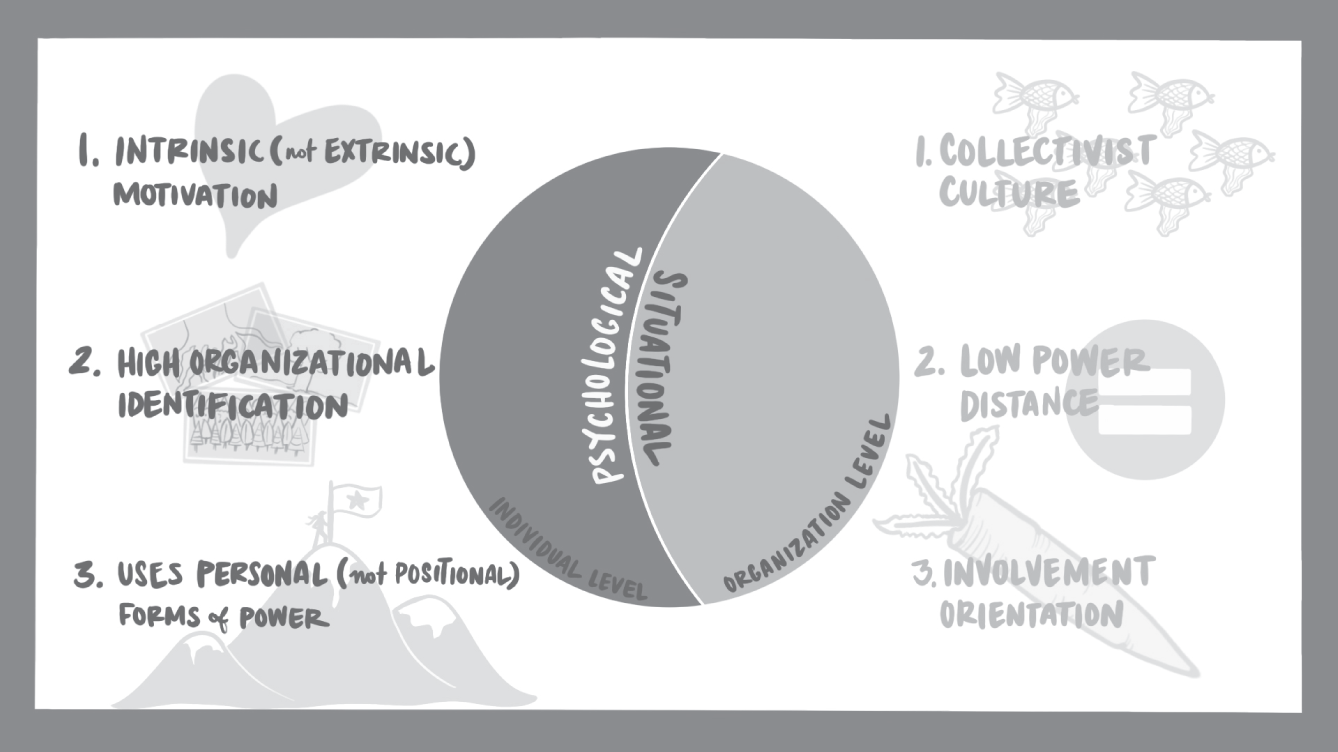
Illustration 3 STEWARDSHIP
Resource-Based View
The resource-based view (RBV) of the firm suggests that firms survive based on their ability to combine heterogeneous and imperfectly mobile resources. Broadly, the RBV incorporates the complex, idiosyncratic, and unique nature of a firm's internal processes and intangible assets, including the values, beliefs, symbols, and interpersonal relationships that individuals or groups within the firm possess. As such, the RBV focuses on an analysis of the nature, characteristics, and potential of a firm's resource base and assumes that each firm's internal resources and capabilities are heterogeneous, which ultimately delivers a competitive advantage. Barney (1991) identified that in order to contribute optimally to firm sustainability, resources must be valuable, rare, imperfectly imitable, and non-substitutable (VRIN).
Resources are defined as anything that could be thought of as a firm's strength or weakness and at any given time could be defined as those (tangible and intangible) assets tied semi-permanently to the firm. Firm resources in the RBV perspective fall into four capital-related categories: physical capital, human capital, organizational capital, and process capital. Overcoming newness means that the venture has been able to distinguish itself from others by building a unique combination of resources in these categories.
Using the RBV framework, Sirmon and Hitt (2003) argued that family businesses evaluate, acquire, shed, bundle, and leverage their resources in ways that are different from those of non-family businesses. In part, these unique resources can emerge from the fact that family members often also act as owners and/or managers. In the family business context, the term “familiness” defines the unique bundle of idiosyncratic resources and capabilities that family firms hold (Habbershon and Williams, 1999). As such, familiness is one of the intangible factors in the RBV (Illustration 4).
Identifying the resource categories that are idiosyncratic is only part of the process. As, if not more important, is understanding what the firm does with resource-related processes or actions. Effectively managing the resources is crucial to creating a competitive advantage and this requires an understanding of how resources are accumulated, bundled, and leveraged. More specifically, Sirmon and colleagues consider resource management to include structuring (i.e. acquiring, accumulating, and divesting) the portfolio of resources, bundling (i.e. stabilizing, enriching, and pioneering) resources to build capabilities, and leveraging (i.e. mobilizing, coordinating, and deploying) capabilities in the marketplace. The synchronization of these processes is important to create value and, in the context of this conversation, contribute optimally to continuity.
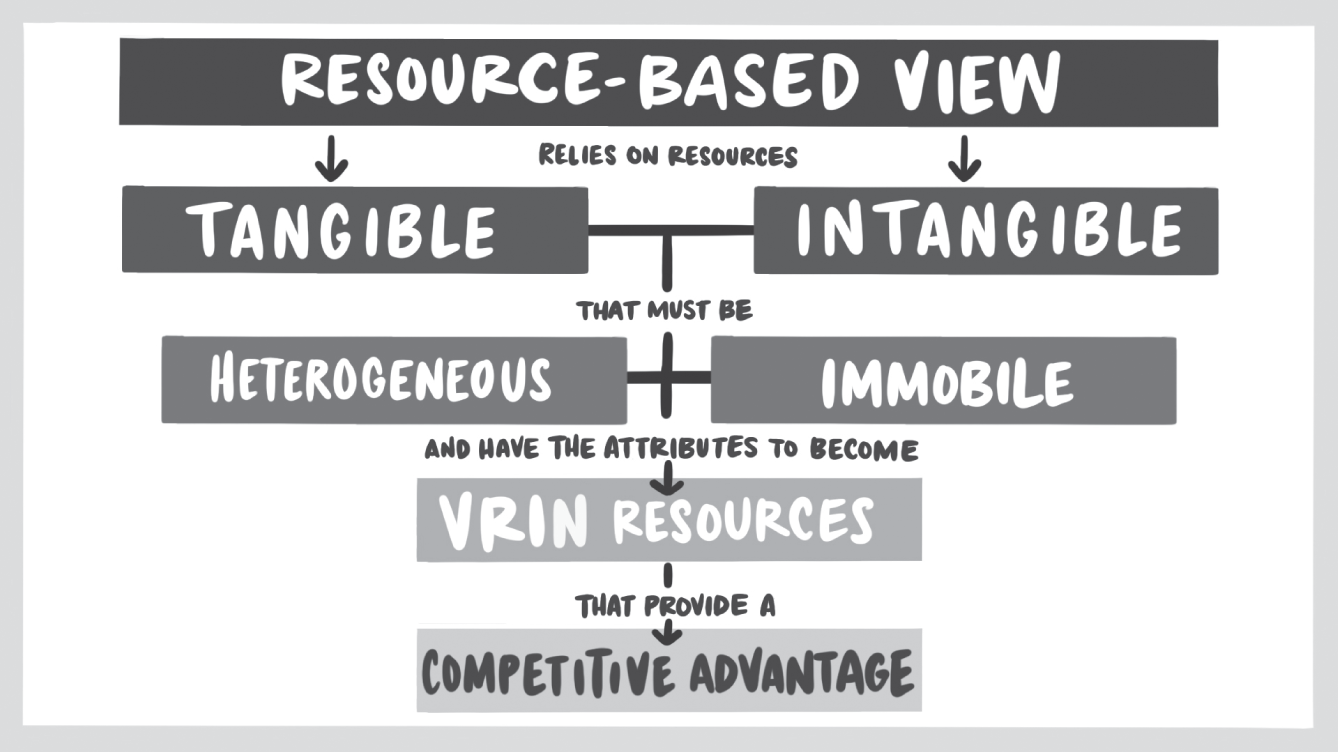
Illustration 4 RESOURCE-BASED VIEW
Principal Cost Theory
An additional, very useful component in the theoretical understanding of family enterprises, and how they improve the chances of continuity, is principal cost theory (Goshen and Squire 2010).
The two major cost dimensions or components of principal cost theory are conflict and competence (Illustration 5). The argument here is something that has long been overlooked: that there are costs in the appointment of principals. Where these costs manifest in the continuity model generation perspective is when owners are ill-prepared for the responsibility of ownership. This is also the case for directors, but that is covered largely by the agency cost argument. Regardless, understanding or appreciating that owners are potentially compromising their potential by falling victim to one or both of these principal costs characteristics is important.
Like many of the dimensions included in the 21 frameworks, the dimensions of conflict and competence are easy to interpret, remember, and explain. These two dimensions and how they apply in family enterprise are fundamental for those committed to continuity. Indeed, the primary objective as a continuity model generation member is to do whatever it takes to put the family enterprise in position for seamless continuation. That is not to say this is a simple task and there won't be plenty of opportunity to engage in conflict. For example, not everyone will be convinced that the conversation should move from traditional succession planning to a new mindset evolving toward Continuity Model Generation; there will be pushback. Expecting this pushback and framing it in terms of the principal cost is a simple solution.
Similarly, confusion around the concept of competence is likely and should be anticipated. The solution lies in explaining that costs will be incurred in the ownership group if people are not prepared for the responsibilities of ownership. This does not point the finger at any one person but alerts the collective of the issue, which can be addressed through education and communication. In reality, this is not a hard sell. As will become more evident throughout this book, Continuity Model Generation proponents seek a fresh, unifying approach to reduce conflict and tension within, between, and among stakeholders in the family enterprise system. This conflict and tension, in principal–cost theoretical terms, is explainable through the dimensions of (i) conflict of interest, and (ii) individual competency, both of which can be addressed through systematic education and communication.
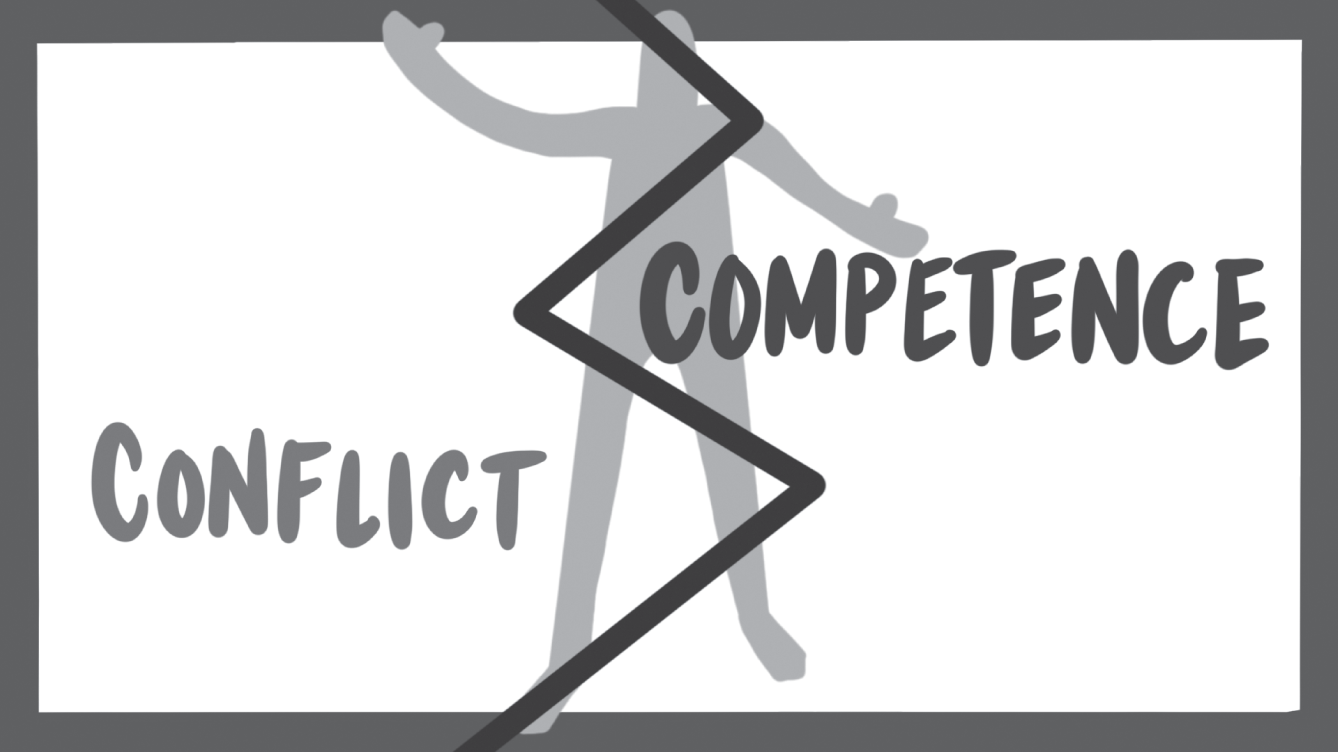
Illustration 5 PRINCIPAL COST
Two Complementary Logics
One simple way to understand what's different about family enterprises is to consider that they are driven by two complementary logics. Specifically, they pursue economic and social agendas concurrently. They balance doing well and doing good. They are committed to a healthy business with a long-term perspective characterized by patient capital and at the same time dedicated to contributing to the social wellbeing of their family, employees, and the communities in which they operate. Understanding this keystone characteristic is important for the development of a continuity model mindset.
Again, this is not hard to understand, and for some it may even sound overly simplistic. But in order to set a solid foundation and to educate now- and next-generation members, simple messages are the best. By framing the distinction as two complementary logics—those associated with economic and social agendas—you can share a simple, easily understood “story.” Simple stories are best. It is also possible to draw this distinction to explain something vital. The way I like to do this is by drawing two connected circles, one with a heart and the other with a dollar sign. That picture paints more than a thousand words, leaving nothing more to be said. I encourage you to test this approach. Actually, throughout the book you'll find simple-to-replicate images that bring the ideas here to life effectively and efficiently. None are simpler than this one (Illustration 6).
But to understand the logics concepts even further, consider two exemplars of them: S.C. Johnson and Corning.
Samuel C. Johnson, then-fourth-generation leader of S.C. Johnson, captures his firm's economic and social motivations in his collection of essays to celebrate the company's one-hundred-year anniversary in 1986. He writes, “when family ownership places a family member in control of a company, and everyone in the firm knows clearly who the boss is, and who will still be the boss in five or ten years hence, then there's a palpable air of stability” (Johnson 1988, p. 7). The Johnsons expect brave decision-making by their generational leaders and have a proud history of each generation bringing something new to the enterprise: “that is, something that hadn't been thought of by—and beyond the visions of—the previous generations” (Johnson 1988, p. 8). At the same time, S.C. Johnson's leaders are acutely aware that they serve under the watchful eye of the founders. As Sam Johnson pointed out, family companies have the capacity to “do things of social or cultural value that a public company might be reluctant even to entertain,” as they have the discretion to “do those things to contribute to enhance the communities in which we live and work without having to explain it to thousands and thousands of people over and over” (Johnson 1988, p. 13).
The social and economic interplay manifests in the US city of Racine, Wisconsin, home of the S.C. Johnson organization. A recent visit confirmed the prominence of the Johnson family in the town; beyond core business activities, other commercial operations include the Johnson Financial Group, the Johnson Bank, and Johnson Outdoors. There is also Sam Johnson Parkway, which leads to a Johnson-funded public square. The Johnson family has also endowed the Racine Museum of Art.
Another example is in the city of Corning, New York, home of the fifth-generation Houghton family's Corning Glass Works, where family connections and values account for much of the business's character and culture, with a focus on the social and economic wellbeing of the firm and its environment. When floodwaters destroyed the glassworks in 1972 and threatened the continuity of the business, then-Chairman Amory Houghton went on local radio to rally the company and community, “We are not only going to rebuild what we have lost, but we are going to add significantly to our manufacturing facilities in one of our plants…I want those of you who are employees of our company to know that as long as we respond well to our customer's needs your jobs are secure. Not a flood, nor a hurricane, not any other act of nature is going to jeopardize this. You are the Corning Glass Works, particularly in this city which is our home and our headquarters” (Dyer and Gross, 2001, p. 313).
Most notable is the positioning of continuity as the family's metric of success. By positioning this as their desired outcome and highlighting the economic and social aspects of achieving this, they acknowledge the role that their business families play in commerce and society.

Illustration 6 TWO COMPLEMENTARY LOGICS
Three Circles Framework
The three circle Venn diagram is synonymous with family enterprising and, as a go-to model since the mid-1980s, has reached consensus as a paradigm in this space. Much has been written about the three circles model, and a quick Google™ search will return plenty of variations on it (I encourage you to do that search). But while there are many variations, the overall message remains the same: that there are three independent and interdependent circles in family enterprise, and these circles are in constant flux, which helps explain the complexities and challenges that those involved in enterprising families face.
Like many easy-to-digest frameworks, the simplicity of the three circles model masks its complexity. Indeed, few in my experience have taken the time to appreciate the richness and explanatory power of this framework. Allow me to share my interpretation. But “my” is a mischaracterization, because the way I view the world has been influenced by many, as I explained in the Acknowledgements.
As with other frameworks, to really appreciate the three circles you need to draw it. So, do that: actually, take a piece of paper and draw three equal-sized intersecting circles. Label the circles “family,” “owners,” and “managers.” The reason the third is labeled “managers” and not “business” is that the former keeps the level of analysis the same across circles; they are all people. This may seem pedantic, but it really is the best way to explain the interaction of these three systems. I will call them “systems” for ease of interpretation, though many purists would argue that they are not in fact systems. That conversation is beyond this book's scope.
So, now on the paper in front of you, there should be three circles denoting family, owners, and managers. The order of the labels doesn't matter. However, I have heard that the pioneers of this approach prefer to put the owners in the top circle because, in their words, “the ownership system overrules both the family and the managers system.” But that conversation, too, is a distraction. The owner and family labels are easy to understand. The manager label takes some getting used to. To repeat, the managers are people as opposed to businesses, which are not people, though obviously operated by people. Managers manage on behalf of the owners, some, but not all, of whom will be in management. This is the fundamental distinction.
Now let's look at each of the systems/circles individually. Concentrate first on the owner circle. As a truly committed continuity model generation member, the first thing you need to do is add the word “stewards” to the word “owners.” So you have a new label, “owners–stewards.” Straightaway you have shifted the focus to continuity. Do the same for the other two circles/systems, adding “stewards” to their labels. Your Venn diagram now looks different. The simple relabeling of the three circles to include the word “stewards” makes the model more in line with the concept of continuity.
Back to the ownership circle, or more correctly, the owners–stewards system. What needs to be understood here, as you appreciate the richness of this model, is that there is heterogeneity within the ownership–stewardship system: different owners interpret their role as owners, and the utility that they receive from being owners, differently. So, while it is easy to simply relabel the system “owners–stewards,” this won't necessarily be interpreted similarly by the increasing number of individuals in the ownership system.
What continuity modelers do to explain the complexity of ownership is to draw a continuum. So, include a continuum in the owners–stewards circle. The anchors of this continuum, and here we borrow from the complementary logics argument introduced earlier, are a dollar sign and a heart. Or, more specifically, you may prefer to describe these as economic utility and psychological utility. Regardless, understand that not all owners are the same, so they can be plotted along this continuum; importantly, where they are located will change over time. Also understand that this is not abnormal. This is normal. The beauty of approaching the three circles diagram with this granularity is that it shines a light on the systems both individually and collectively. By simply understanding that owners will not be the same, that they will have different needs and expectations, is enlightening. Some will be there primarily for the dividends; others will be there for the psychological and emotional attachment that they have to the family brand, to the clan, to the reputation. It will vary by degrees. But it will almost certainly vary.
The continuity model approach, as will be demonstrated throughout this book, is more expansive than many of the other approaches most readers will be familiar with. The idea explained above, of using the ownership system to include the concept of owners–stewards and broadening understanding of the utility gained by individual owners, is a good example of this expansiveness. Hopefully, this first example will prepare you to expand your horizons in other ways, such as appreciating the differences between continuity modeling and succession planning, as we'll discuss.
Before leaving the owners–stewards system, let's consider other ways to make use of this fundamental dimension of family enterprising. Continuity modelers are knowledgeable about, but not obsessed by, what it is that they actually own (as we'll discuss in Part II, which covers the development of the Continuity Canvas). Using the owners–stewards circle to illustrate, consider for this exercise what it is that you own: what you own collectively (with others), individually, in joint venture relationships, in partnerships, or in legal entities such as discretionary trusts. Any conversation on these topics would be housed in the owners–stewards circle. At this point, I'll assume that you appreciate more fully the richness of this first of three systems, more so than before you started this exercise. So, as not to overwhelm, let's move to the family circle, which you should now consider the family–stewards circle.
Like the other circles or systems in the model, this one is in flux. But this is the system that distinguishes business families or family enterprises from other entities. Other entities have to worry only about ownership and what it is that they are responsible to manage. Importantly, the family–stewards system evolves into a family of families. That simple framing is important. The best way to describe that, or depict it figuratively, is by including smaller circles within the larger one you've drawn. You now have something that resembles a simple polka dot image. If only the underlying dynamics were that simple!
In contrast, the family of families is susceptible to many unforeseen and challenging events. Indeed, the contemporary family itself is hard to describe. As someone once said about family offices, “If you've seen one family office you have seen one family office”; but the same can be said about families. They are all the same but different, and each family must learn to understand and manage what makes it different from others. This is a challenge, to be sure. But this is not the place to examine in detail and categorize carefully the diverse family makeups across society; rather, here we will flag that a focus on continuity will involve an understanding that the family in family enterprise represents a convoluted, ever-changing dynamic. For example, there are societal norm challenges in the Western world based on different views of marriage than those of the previous generation; the official recognition of same-sex marriages and partnerships has challenged the previously held definition of “family”. Add to that the reality that a considerable proportion of marriages end in divorce, yielding many more single-parent and hybrid families than in the past, and the idea of labeling the system as family–stewards seems admittedly simplistic and idealistic.
But ultimately that doesn't matter. What matters is that no matter what constellation of family makeups constitute the family–stewards system, the focus is on ensuring that there is unity of purpose. Fostering a commitment to engage meaningfully with one another for the purpose of increasing chances of continuity: that's the right message to send those who populate whatever form or structure that constitutes the evolving family of families. Again, it is important to emphasize that a cursory examination of the three systems that make up the traditional family enterprise Venn diagram would not have elicited such richness.
Let's move now to the third system: the managers–stewards, or those who manage on behalf of the owners–stewards. In the owners–stewards system, my suggestion was that you draw a continuum bounded at one end with a heart and the other a dollar sign, or labeled “financial” and “psychological.” In the family–stewards circle I encouraged you to draw smaller family units within the larger family system. In the manager–stewards circle I suggest the addition of a series of bullet points. This will enable a list of what it is that manager–stewards must manage. The list will include, for example, the operating business (sometimes called the legacy business), real estate holdings, liquid assets, philanthropic activities, joint ventures, and the like. The older and more established the business, the more bullet points that are likely to be included in this system. As with the other two systems, this modification adds a level of detail that helps you understand and appreciate how this simple framework can be used to tell such a complex story.
And that is the key message for all of these frameworks: they are a simple way to tell complex stories.
So, in front of you now should be three circles with edited labels and continuums, circles, and bullet points. The next step is to form the circles into dyads, to look at the framework in yet another way. But there is no need to draw a revised set of circles. Rather, just focus on one pairing of circles at a time. First, consider the overlap between the owners and managers. The argument here, and a key component of the approach we will use to build the Continuity Canvas in Part II, is that there is tension, or the potential for tension, between the managers–stewards and the owners–stewards. Recall that the managers–stewards manage on behalf of the owners–stewards. What is required to reduce the potential for conflict or tension is a strategic plan to ensure alignment between these two groups. As will be shown in Part II, this is one of four essential plans that make up the Continuity Canvas. We use the same approach, not surprisingly, at the intersection of the owners–stewards and family–stewards systems. In this dyad, we address the potential for tension through development of an asset, wealth, and estate plan. Moving to the overlap between the family–stewards and the managers–stewards system, to address the potential for tension between these two systems requires a successors’ talent development plan. Finally, at the center of the three systems, where the three circles overlap, there is again potential for tension. To reduce this tension, or its potential, and increase the likelihood of continuity, the Continuity Model Generation commits to the development and implementation of a governance plan.
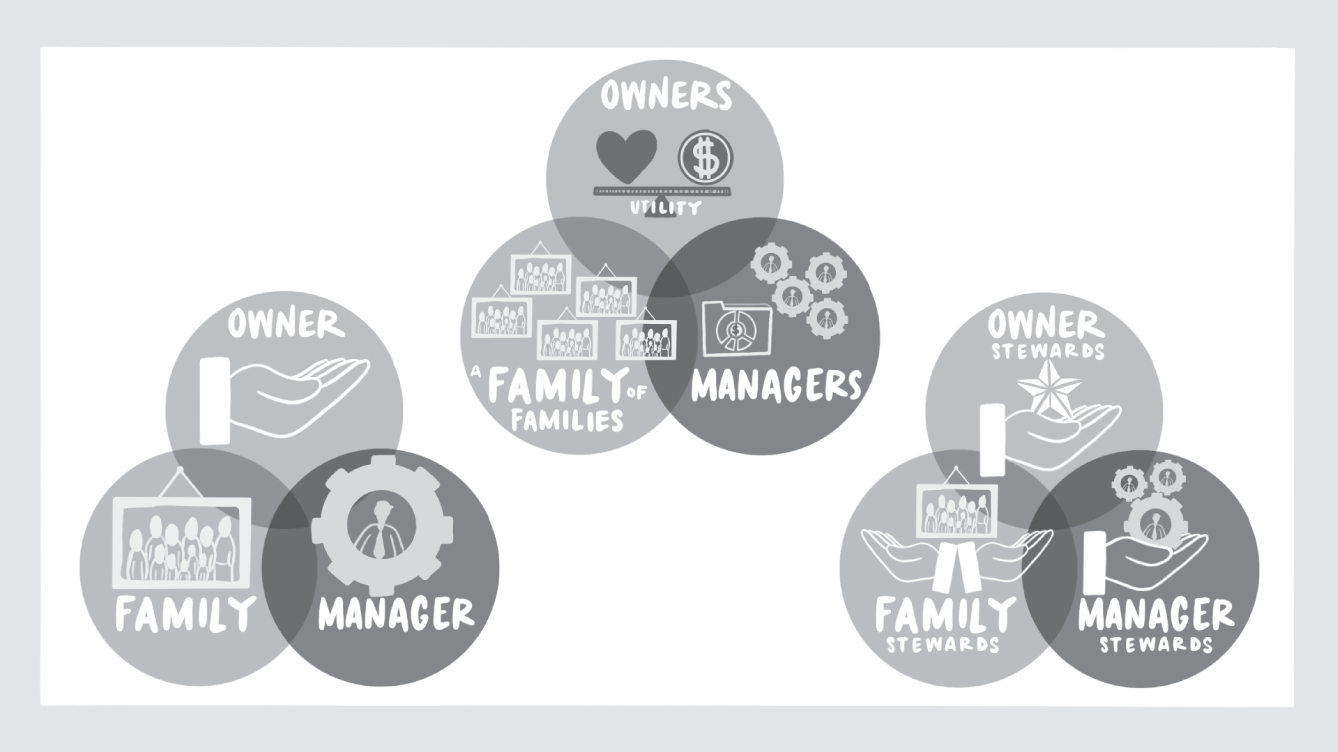
Illustration 7 FULLY DEVELOPED THREE CIRCLES FRAMEWORK
As stated earlier, the simplicity of the three circles framework masks its richness. While previous generations have acknowledged that the paradigm is useful in distinguishing what is unique to business-owning families, the Continuity Model Generation extends a level of sophistication to this framework, as suggested in the sections above (Illustration 7).
Upon adding the three circles framework to the four foundational theories (agency, stewardship, resource-based view, and principal cost) as well as to the complementary logics (economic and social) approach, it is apparent why this meta-framework is the keystone in the arch of continuity modeling. Feel free to reread this section and add your voice.
